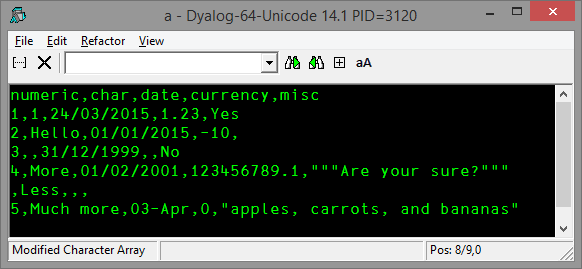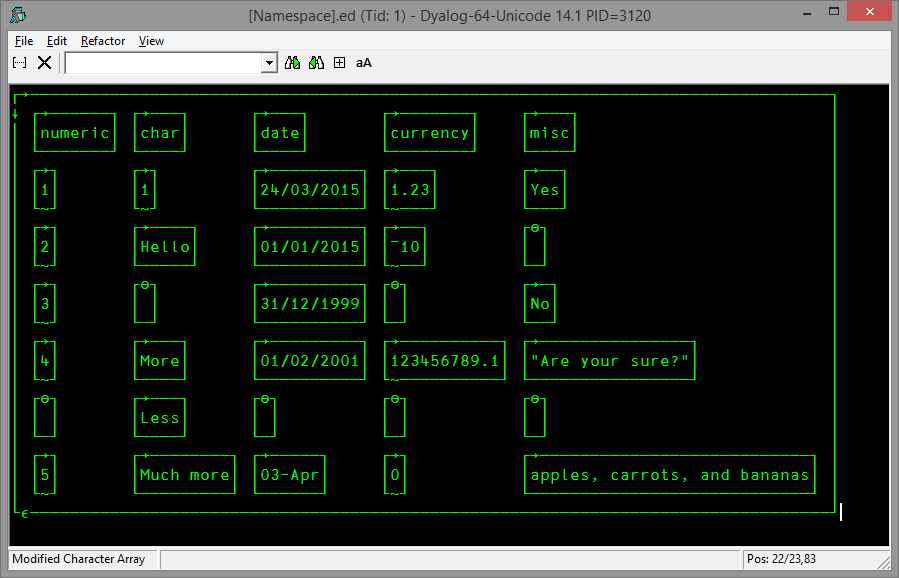|
Size: 10104
Comment: more typos
|
Size: 10124
Comment:
|
| Deletions are marked like this. | Additions are marked like this. |
| Line 54: | Line 54: |
| r←PartitionRecordsWithDyalog string;masked;cr;lf;bool; | r←PartitionRecordsWithDyalog string;masked;cr;lf;bool |
| Line 68: | Line 68: |
| ⍝ need to be masked before we decide where recors really starts. | ⍝ need to be masked before we decide where records really start. |
| Line 91: | Line 91: |
| →0 | |
| Line 190: | Line 189: |
| Line 191: | Line 191: |
| ---- CategoryArticles |
CSV to APL
Contents
CSV stands for comma separated values. Those files are still used to transport tabular data between applications that are not directly connected. The files can be edited with any spreadsheet application like Microsoft Excel.
There are some things one need to know about CSV file in order to deal with them:
- Fields are separated by commas. Well, mostly.
- Records are separated with system end of line characters, CRLF (ASCII 13 Dec or 0D Hex and ASCII 10 Dec or 0A Hex respectively) for Windows, LF for Unix, and CR for Mac
If a field contains either a comma or a double quote or one of the end line chars, either the char(s) or the whole contents needs to be escaped. Excel escapes these values by embedding the field inside a set of double quotes. For example, a single cell with the text apples, carrots, and oranges becomes "apples, carrots, and oranges".
Strictly speaking, the delimiter is not defined in the specs. Some banks offer downloads where a semicolon is used instead of a comma. You might wonder why the name of this format is Comma Separated Values, but anyway. Several versions of Excel do not recognize a semicolon as a separator.
For details and background information see:
Note that the format comes with a nasty built-in-problem: there is no way to recognize a cell as being numeric. Converting cells which only contain a proper number does not help because if you enter a digit with a leading quote, Excel handles this as text but again this cannot be recognized as text in the csv file. The only solution is therefore to make an informed guess. This informed guess can vary from file to file and person to person, so please look at the functions Csv2MatrixWithDyalog and Csv2Numeric below to see if you want to change them before you start using this.
Reading and writing CSV files using APLX
Reading and writing CSV files in APLX is straightforward; You can just use the ⎕IMPORT and ⎕EXPORT system commands, specifying CSV as the format to use:
⍝ Reading a CSV file... myVariable←⎕IMPORT 'C:\Users\simon\Desktop\spreadsheet_data.csv' 'csv' ⍝ Writing a CSV file some_data←2 3⍴'APL' 'is' 'fine, very fine' 1 2.2 ¯3 some_data ⎕EXPORT 'C:\Users\simon\Desktop\new_data.csv' 'csv'
For another example of reading a CSV file of Google finance data and charting it, see here
Reading a CSV file using Dyalog APL
Given an Excel spreadsheet that looks like this:
Saving this into a csv file, the file can be read into APL. The variable would look like this:

To convert this into an APL matrix is a two-step-process:
- partition the simple string from file
- extract the data and build up the APL matrix
First step: partition the string being read from file
With the following two functions this variable can be transformed into an APL array where every item represents a record. Data masked by " remain unchanged. The functions can deal with files from Unix, Mac and Windows.
r←PartitionRecordsWithDyalog string;masked;cr;lf;bool
⍝ Takes a string and partitions records.
⍝ Can deal with Mac/Unix/Windows files.
⍝ For that, CR+LF as well as single LFs are converted into CR.
⍝ CR is then used to partition "string".
⎕IO←1 ⋄ ⎕ML←3
(cr lf)←⎕TC[2 3] ⍝ <CarriageReturn> and <LineFeed>
:If 0<+/bool←(cr,lf)⍷string ⍝ are there any cr+lf in "string"?
string←(~bool)/string ⍝ Let only the cr survive
:EndIf
:If 0<+/bool←cr=string ⍝ Are there still any cr's?
(bool/string)←lf ⍝ Convert them to lf
:EndIf
⍝ In the remaining string, there might be lf's inside text, Those
⍝ need to be masked before we decide where records really start.
masked←~{⍵∨≠\⍵}'"'=string ⍝ what is not escaped (between "")
:If 1∊bool←lf=masked/string ⍝ are there any unmasked lf in "string"?
r←(~masked\bool)⊂string
:Else ⍝ so it's a single record
r←⊂string
:EndIf
Second step: extract the real data
r←{sep}Csv2MatrixWithDyalog csv;bool;⎕IO
⍝ Convert vector-of-text-vectors "csv" that is assumed to
⍝ come from a *.csv file and which got already partitioned
⍝ into an APL matrix. Takes care of escaped stuff.
⍝ "sep" defaults to a comma but that can be changed by specifying a left argument.
⎕IO←1 ⋄ ⎕ML←3
sep←{2=⎕NC ⍵:⍎⍵ ⋄ ','}'sep'
r←(⌽∨\0≠⌽↑∘⍴¨csv)/csv ⍝ remove empty stuff from the end if any
bool←{~{⍵∨≠\⍵}'"'=⍵}¨r ⍝ prepare booleans useful to mask escaped stuff
r←⊃r{⍺⊂⍨⍵≠sep}¨bool{⍺\⍺/⍵}¨r ⍝ partition fields by unmasked commas
r←{'"'≠1⍴⍵:⍵ ⋄ ¯1↓1↓⍵}¨r ⍝ remove leading and trailing "
r←Csv2Numeric r ⍝ Convert numeric cells
r←(~'""'∘⍷¨r)/¨r ⍝ double-" into a single one
⍝ test← ,⊂'-12,"€ 1,23","1,23 €",1234 abc,"£1,234"'
⍝ (,¨1 5⍴¯12 '€ 1,23' 1.23 1234 '£1,234')≡ Csv2MatrixWithDyalog testThere are two places where this code does not do exactly what Kai says: "€ 1,23" is left unchanged; scalar numbers are changed back to one element vectors by the phrase
r←(~'""'∘⍷¨r)/¨r on the last line.
The original version above changes "1,23" into 1.23. It also converts "2 Bridge Street" into 2. I want to convert "£1,235" into 1235 and to leave addresses unchanged, so here are two alternatives :
The original:
r←Csv2Numeric r;buffer
⍝ Kai's version from APLWIKI page CsvToApl
buffer←{0=+/bool←'-'=w←⍵:⍵ ⋄ (bool/w)←'¯' ⋄ w}¨r ⍝ "buffer" is a copy of r with "¯" for "-"
buffer←{0=+/bool←','=w←⍵:⍵ ⋄ (bool/w)←'.' ⋄ w}¨buffer ⍝ "," gets "."
r←buffer{↑1⊃v←⎕VFI ⍺:↑2⊃v ⋄ ⍵}¨r ⍝ make fields with appropriate content numeric scalars
→0
⍝ test← '-12' '€ 1,23' '1,23 €' '1234 abc' '£1,234'
⍝ ¯12 '€ 1,23' 1.23 1234 '£1,234'≡ Csv2Numeric testand my alternative:
r←Csv2NumericEllis r;buffer
⍝ Ellis's version
buffer←{0=+/bool←'-'=w←⍵:⍵ ⋄ (bool/w)←'¯' ⋄ w}¨r ⍝ "buffer" is a copy of r with "¯" for "-"
buffer←{('∘',⍵)[1+(' '≠⍵)×⍳⍴⍵]}¨buffer~¨⊂'£,' ⍝ blank to jot, remove £ and comma
r←buffer{↑1⊃v←⎕VFI ⍺:↑2⊃v ⋄ ⍵}¨r ⍝ make fields with appropriate content numeric scalars
→0
⍝ test← '-12' '€ 1,23' '1,23 €' '1234 abc' '£1,234'
⍝ ¯12 '€ 1,23' '1,23 €' '1234 abc' 1234≡ Csv2NumericEllis testI have another that only converts when a whole column is potentially numeric. It is so easy for you to write your own version that I do not see any point in providing more alternatives
The Final Step
Put it all together:
r←{sep} DealWithCsv filename;data
⍝ Read "filename" which is assumed to be a *.csv file
⍝ and convert it into a matrix
sep←{2=⎕NC ⍵:⍎⍵ ⋄ ','}'sep'
data←FileRead filename
data←PartitionRecordsWithDyalog data
r←sep Csv2MatrixWithDyalog dataThe resulting variable in APL would look like this:

Note that the 1 in the second row/second column got converted into the number because the contents of the cell remained of digits only. However, in the original Excel spreadsheet that cell is text; this is indicated by the small green triangle. This information is not contained in the CSV file.
Writing a CSV file using Dyalog APL
Given an APL array like:
⎕←2 3⍴'APL' 'is' 'fine, very fine' 1 2.2 ¯3 APL is fine, very fine 1 2.2 ¯3
The following function takes such an array as right argument and converts it into a string that can be written to a file with the extension ".csv". The left argument defaults to "windows" and can be "unix" or "mac" as well. Note that the left argument is case sensitive. The left argument is used to determine the appropriate record separator.
r←{os}Array2CsvWithDyalog array;cr;lf;sep;bool;IsChar;dq
⎕IO←1 ⋄ ⎕ML←3
:If 0=⎕NC'os'
os←'windows'
:EndIf
'Invalid left argument; must be one of: windows, unix, mac'⎕SIGNAL 11/⍨~(⊂os)∊'windows' 'unix' 'mac'
'Right argument must have a depth of 2'⎕SIGNAL 11/⍨2≠≡array
'Right argument must be either a matrix or a vector'⎕SIGNAL 11/⍨~(⍴⍴array)∊1 2
(cr lf)←⎕TC[2 3] ⍝ <CarriageReturn> and <LineFeed>
sep←('windows' 'unix' 'mac'⍳⊂os)⊃(cr,lf)lf cr ⍝ select proper record separator
IsChar←{0 2∊⍨10|⎕DR ⍵} ⍝ Version 12 compatible
bool←,~IsChar¨array ⍝ locate number
(bool/,array)←⍕¨bool/,array ⍝ make numbers text
dq←,'"'∊¨array ⍝ Where are double quotes in the text?
(dq/,array)←{b←'"'=w←⍵ ⋄ (b/w)←⊂'""' ⋄ ⊃,/w}¨dq/,array ⍝ Double the double quotes
bool←dq∨,(lf∊¨array)∨','∊¨array ⍝ where are special chars used?
(bool/,array)←{'"',⍵,'"'}¨bool/,array ⍝ escape field with special chars
bool←'"'∊¨array ⍝ where are special chars used?
array←{⊃{⍺,',',⍵}/⍵}¨↓array ⍝ separate fields by comma
r←⊃,/array,¨⊂sep ⍝ make it simpel
((r='¯')/r)←'-'⍝ Example: #.Array2CsvWithDyalog 2 3⍴'APL' 'really "really" is' 'fine, very fine' 1 2.2 ¯3 APL,"really ""really"" is","fine, very fine" 1,2.2,-3
Author: KaiJaeger
 APL Wiki
APL Wiki